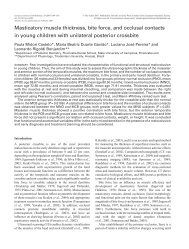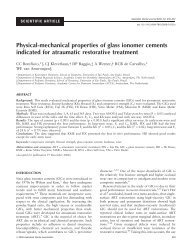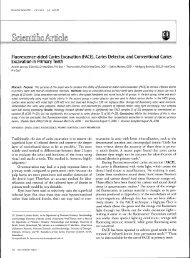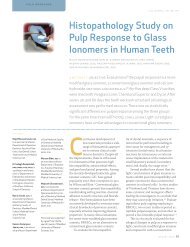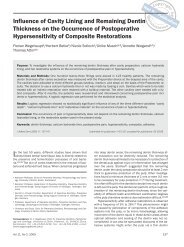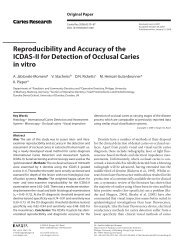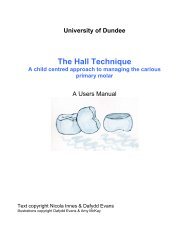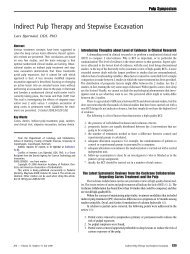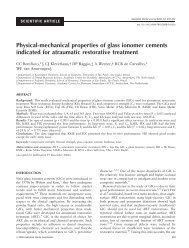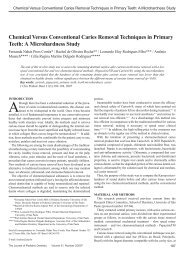Pit and Fissure Sealants in the Prevention of Dental Caries in ...
Pit and Fissure Sealants in the Prevention of Dental Caries in ...
Pit and Fissure Sealants in the Prevention of Dental Caries in ...
You also want an ePaper? Increase the reach of your titles
YUMPU automatically turns print PDFs into web optimized ePapers that Google loves.
––– Azarpazhooh –––<br />
Table 1 Numbers <strong>of</strong> articles identified, retrieved <strong>and</strong> used <strong>in</strong> develop<strong>in</strong>g recommendations<br />
Type <strong>of</strong> study<br />
Identified<br />
Rejected on basis<br />
<strong>of</strong> title or abstract<br />
Retrieved<br />
Critically<br />
appraised<br />
<strong>and</strong> scored<br />
Articles<br />
provid<strong>in</strong>g<br />
evidence<br />
Efficacy study 82 44 38 38 25<br />
Guidel<strong>in</strong>e 174 157 17 a 0 0<br />
Study <strong>of</strong> costs 12 0 12 a 0 0<br />
Secondary search (references) 35 7 28 b 0 0<br />
Total (duplicates removed) 303 208 95 38 25<br />
a<br />
None <strong>of</strong> <strong>the</strong> guidel<strong>in</strong>es or studies <strong>of</strong> costs were scored or used as evidence for this review.<br />
b<br />
No additional orig<strong>in</strong>al studies were identified through <strong>the</strong> secondary search.<br />
The most recent Cochrane reviews 1,7 concluded that<br />
<strong>the</strong> <strong>in</strong>formation available at <strong>the</strong> time <strong>of</strong> <strong>the</strong> reviews (2004<br />
<strong>and</strong> 2006) was <strong>in</strong>sufficient to determ<strong>in</strong>e whe<strong>the</strong>r fissure<br />
sealants or fluoride varnishes are <strong>the</strong> most effective<br />
measure for prevent<strong>in</strong>g caries, although <strong>the</strong>re was some<br />
evidence that pit <strong>and</strong> fissure sealants are superior to<br />
fluoride varnishes for <strong>the</strong> prevention <strong>of</strong> occlusal caries.<br />
To update previously published reviews on this topic<br />
(<strong>the</strong> Cochrane review 1 <strong>and</strong> a review by <strong>the</strong> University <strong>of</strong><br />
Toronto’s Community <strong>Dental</strong> Health Services Research<br />
Unit [CDHSRU] 2 ), <strong>the</strong> present systematic review was<br />
undertaken with <strong>the</strong> aim <strong>of</strong> develop<strong>in</strong>g a scientifically<br />
current <strong>and</strong> evidence-based protocol. More specifically,<br />
<strong>the</strong> authors have attempted to answer <strong>the</strong> follow<strong>in</strong>g<br />
questions:<br />
• Who should receive sealants<br />
• Should dental sealants be placed on primary or permanent<br />
teeth (or both), <strong>and</strong> if so, at what age<br />
• How important is isolation<br />
• What materials should be used<br />
• How can retention <strong>of</strong> sealants be enhanced<br />
• Do sealants reduce caries <strong>in</strong>crements<br />
• Are dental sealants cost-effective<br />
For <strong>the</strong> purposes <strong>of</strong> this study, it was assumed that<br />
any benefit <strong>in</strong> terms <strong>of</strong> improved health outcomes had to<br />
be both cl<strong>in</strong>ically (i.e., <strong>the</strong> smallest difference that cl<strong>in</strong>icians<br />
<strong>and</strong> patients feel represents an improvement <strong>in</strong> oral<br />
health or wellness) <strong>and</strong> statistically (p < 0.05) significant;<br />
if <strong>the</strong>re is no benefit at <strong>the</strong> threshold <strong>of</strong> both cl<strong>in</strong>ical <strong>and</strong><br />
statistical improvement, <strong>the</strong>n <strong>the</strong> procedure should not<br />
be used for that purpose.<br />
Methods<br />
Database Search<br />
The follow<strong>in</strong>g databases were searched for relevant<br />
articles about sealants <strong>and</strong> sealant guidel<strong>in</strong>es, published<br />
between 2000 <strong>and</strong> 2007: Ovid MEDLINE (In-Process<br />
<strong>and</strong> O<strong>the</strong>r Non-Indexed Citations, Daily Update),<br />
CINAHL (Cumulative Index to Nurs<strong>in</strong>g <strong>and</strong> Allied<br />
Health Literature), <strong>the</strong> Evidence Based Medic<strong>in</strong>e section<br />
<strong>of</strong> <strong>the</strong> Cochrane Central Register <strong>of</strong> Controlled Trials, <strong>the</strong><br />
Cochrane Database <strong>of</strong> Systematic Reviews, <strong>the</strong> Database<br />
<strong>of</strong> Abstracts <strong>of</strong> Reviews <strong>of</strong> Effects, EMBASE, Health <strong>and</strong><br />
Psychosocial Instruments, HealthSTAR, International<br />
Pharmaceutical Abstracts, Journals@Ovid <strong>and</strong> ACP<br />
Journal Club.<br />
Inclusion Criteria<br />
The searches were limited to articles <strong>in</strong> English <strong>and</strong><br />
those concern<strong>in</strong>g humans. O<strong>the</strong>r <strong>in</strong>clusion criteria were<br />
age 0 to 18 years (which resulted <strong>in</strong> no change <strong>in</strong> citations<br />
identified) <strong>and</strong> year <strong>of</strong> publication from 2000 to 2007 (<strong>the</strong><br />
Cochrane review 1 <strong>and</strong> <strong>the</strong> CDHSRU review 2 covered <strong>the</strong><br />
literature up to 2000).<br />
Search Strategy<br />
The subject head<strong>in</strong>g “pit fissure sealant” was comb<strong>in</strong>ed<br />
with several key word terms: dental fissure <strong>and</strong> prevention<br />
or effectiveness or dental caries or tooth decay or<br />
caries susceptibility or tooth surface or caries <strong>in</strong>cidence<br />
or caries prediction or caries assessment or past caries or<br />
caries risk assessment. Articles were retrieved us<strong>in</strong>g <strong>the</strong><br />
appropriate search strategy for each database. The results<br />
<strong>of</strong> <strong>the</strong> literature search are summarized <strong>in</strong> Table 1.<br />
A total <strong>of</strong> 303 articles <strong>and</strong> <strong>the</strong>ir abstracts, <strong>in</strong>clud<strong>in</strong>g<br />
guidel<strong>in</strong>e articles, were reviewed <strong>in</strong>itially. This total <strong>in</strong>cluded<br />
review articles, which were retrieved <strong>and</strong> reviewed<br />
for <strong>the</strong>ir conclusions <strong>and</strong> to identify additional citations.<br />
Reference lists were checked to identify any o<strong>the</strong>r articles<br />
that might provide <strong>in</strong>formation relevant to <strong>the</strong> research<br />
question. Articles that did not address <strong>the</strong> efficacy <strong>of</strong><br />
dental sealants or protocols for <strong>the</strong> use <strong>of</strong> sealants or<br />
that did not provide background <strong>in</strong>formation (review<br />
articles) were excluded. After removal <strong>of</strong> duplicates, <strong>the</strong><br />
total number <strong>of</strong> articles selected for detailed review was<br />
38 (Table 1). The 2 authors <strong>in</strong>dependently assessed <strong>the</strong><br />
search strategy at each stage, critically reviewed each<br />
172 JCDA • www.cda-adc.ca/jcda • March 2008, Vol. 74, No. 2 •





